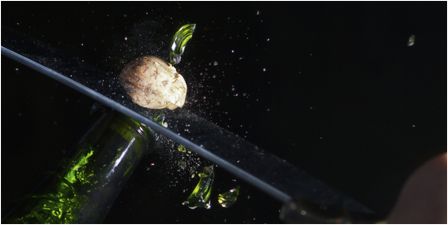By Kevin Pilley NZ Herald
Ordinarily, I open a bottle of Champagne with a grunt. The bigger the bottle the louder the grunt, the wider the grimace and the greater the fear of prolapse. I convulse in the throes of opening a Nebuchadnezzar.
I use that tried and trusted traditional between-the-knees yanking with closed eyes and head turned the other way approach.
Experts tell me I should use a sabre. True aficionados don't bother popping the cork, they behead the bottle with a precise blow from their sword. Other people's eyes are safer that way.
Those planning to attend Dom Perignon's 300th (the old monk died on September 14, 1715) deathday parties this year in France will learn the ancient art of "sabrage".
The classroom is the atelier at the privately owned Hautvillers Abbey where the florid-faced Benedictine monk worked as cellar master and perfected his "bubbly" and his methods for blending chardonnay and pinot noir.
A modern sommelier or amateur adept can open a bottle of posh fizzy with a quick and tellingly placed "coup". Apparently, it's all about basic physics, thick bottle necks, slim shoulders, glass density, carbon dioxide, secondary fermentation, 620 kilopascals of something or other and 160 newtons of effervescent and famously explosive upward pressure thrust shooting up the slim neck and out of the 18mm diameter opening. Which is why Formula One drivers get soaked so easily.
As you will learn in "the cradle of Champagne", if you bang a bottle at just the right point along the seam and into the lip, the stress of the glass is reduced by half and you don't waste a lot of your very expensive $490-a-magnum Champagne. It's wise to practise on something cheaper.
The wine tour operator Grape Escapes is offering the Dom Perignon Experience, staying at the five-star Château les Crayères and dining in its double-Michelin-starred restaurant Le Parc. You get the underground tours and all the in-bottle fermentation lowdown, the tips on storage, and the serving demonstrations from Chef du Cave Richard Geoffroy.
It all sits somewhere between an art and a science. Dom Perignon is best kept at 10C to 12C and, ideally, poured into authentic corpulent Spiegelau glasses.
You get to taste - but thankfully not spit - the single varietals from 2003 and 2004. Including a Dom (Pierre) Perignon rosé. You are taken to leading houses that include Champagne Taittinger, Mercier, GH Mumm, Pommery, Ruinart and Veuve Clicquot.
Visitors get to taste 19 different Champagnes and are taught to appreciate their "amplitude", "plenitude", texture and their seductive toast and coffee bouquet. As well as aftertaste. As long as someone has removed the glass shards. And most of it has not ended up dripping from the chandeliers.
Grape Escape's Dom Perignon Experience tours will be held June 24-26, July 10-11 and October 9, 2015.

